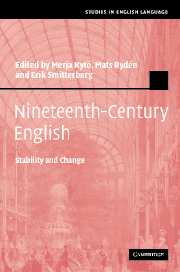Book contents
- Frontmatter
- Contents
- List of plates
- List of figures
- List of tables
- List of contributors
- Acknowledgements
- Introduction: Exploring nineteenth-century English – past and present perspectives
- 1 Modifiers describing women and men in nineteenth-century English
- 2 Words in English Record Office documents of the early 1800s
- 3 The subjunctive in adverbial clauses in nineteenth-century English
- 4 The passive in nineteenth-century scientific writing
- 5 Relativizers in nineteenth-century English
- 6 Anaphoric reference in the nineteenth century: that/those + of constructions
- 7 Adjective comparison in nineteenth-century English
- 8 Nonfinite complement clauses in the nineteenth century: the case of remember
- 9 The in -ing construction in British English, 1800–2000
- 10 Partitive constructions in nineteenth-century English
- Appendix
- References
- Name index
- Subject index
7 - Adjective comparison in nineteenth-century English
Published online by Cambridge University Press: 22 September 2009
- Frontmatter
- Contents
- List of plates
- List of figures
- List of tables
- List of contributors
- Acknowledgements
- Introduction: Exploring nineteenth-century English – past and present perspectives
- 1 Modifiers describing women and men in nineteenth-century English
- 2 Words in English Record Office documents of the early 1800s
- 3 The subjunctive in adverbial clauses in nineteenth-century English
- 4 The passive in nineteenth-century scientific writing
- 5 Relativizers in nineteenth-century English
- 6 Anaphoric reference in the nineteenth century: that/those + of constructions
- 7 Adjective comparison in nineteenth-century English
- 8 Nonfinite complement clauses in the nineteenth century: the case of remember
- 9 The in -ing construction in British English, 1800–2000
- 10 Partitive constructions in nineteenth-century English
- Appendix
- References
- Name index
- Subject index
Summary
Introduction
The patterns of variation in adjective comparison in a synchronic and diachronic perspective is a topic which has recently attracted a good deal of attention (see Kytö 1996a; Kytö and Romaine 1997, 2000; Leech and Culpeper 1997; and Mondorf 2002 and 2003, for a selective sample of studies). This variation involves competition between the inflectional comparative/superlative (e.g. happier/happiest), historically the older form, and the newer periphrastic construction (e.g. more/most elegant). The double comparative (more quicker) and double superlative (e.g. most delightfulest) forms were much less frequent in the history of English. They are now considered non-standard. In this chapter we will extend our analyses by considering patterns of variation in adjective comparison in nineteenth-century English, in the light of the data drawn from the CONCE corpus and, in reference to our earlier work on the topic, the ARCHER corpus (for A Representative Corpus of Historical English Registers, see Biber et al. 1994a and 1994b).
In our studies we have identified some of the major linguistic and extralinguistic factors constraining variation, in particular, word structure and genre. As far as word structure is concerned, we looked at word length and the nature of the word ending as major grammatical determinants influencing the variation, although there are other linguistic factors in need of consideration, as we will show later on in the present study (for earlier observations, see e.g. Leech and Culpeper 1997: 357–8, 366–9, and Mondorf 2002 and 2003).
- Type
- Chapter
- Information
- Nineteenth-Century EnglishStability and Change, pp. 194 - 214Publisher: Cambridge University PressPrint publication year: 2006
- 8
- Cited by



